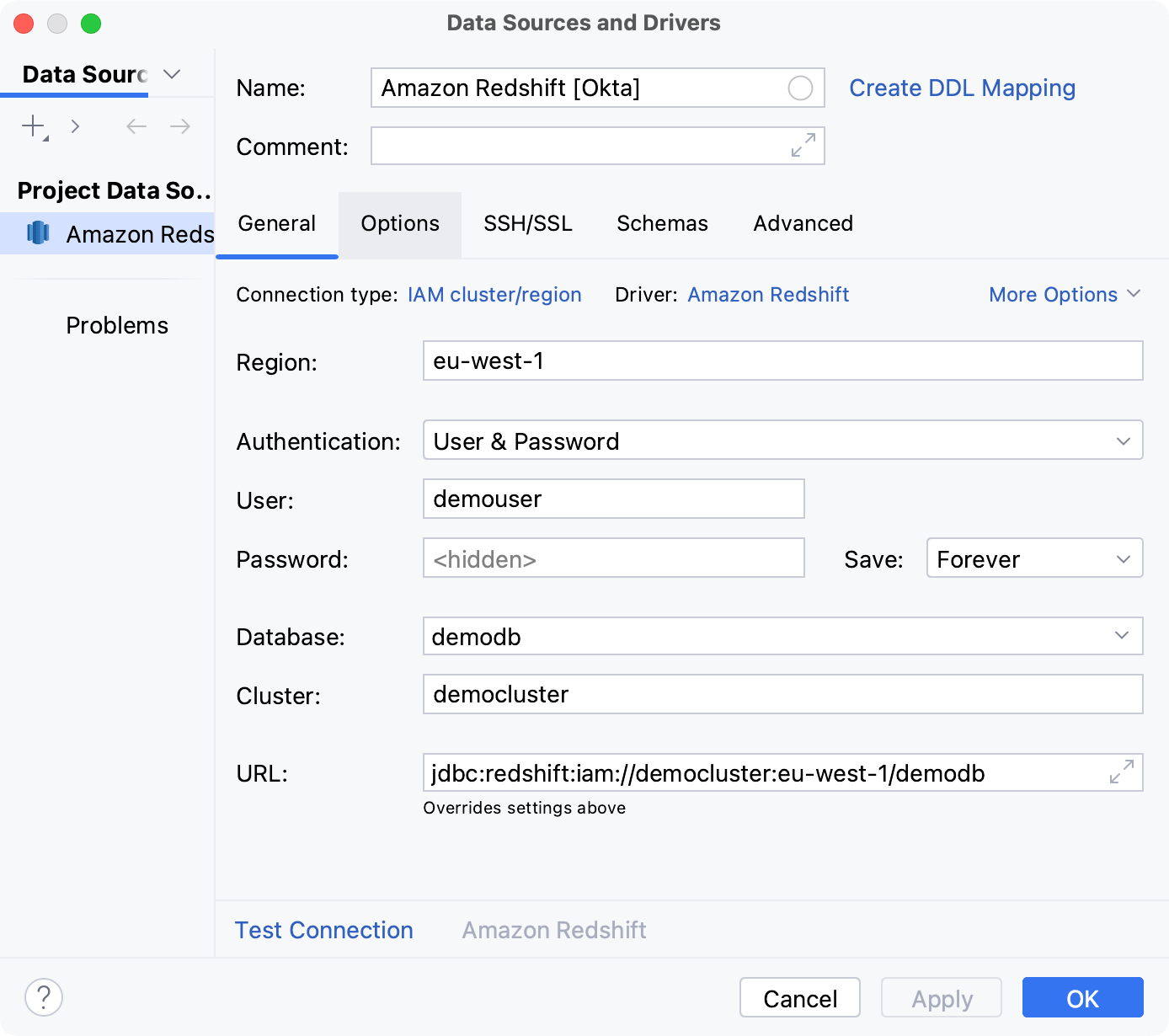Connect to Amazon Redshift with Okta
Official documentation
For full information about Amazon Redshift, refer to the official documentation.
For more versions of Amazon Redshift JDBC driver, refer to the official JDBC driver downloads.
This topic presents a general procedure on how you can create a data source for the connection to your Amazon Redshift database in DataGrip, and run a test connection. It is assumed that you already have the necessary prerequisites and the database is up and running.
Prerequisites
Your Amazon Redshift dashboard must have a Amazon Redshift cluster in it. For more information about the Amazon Redshift cluster, refer to Getting Started with Amazon Redshift.
Connect to an Amazon Redshift database
To connect to the database, create a data source that will store your connection details. You can do this using one of the following ways:
In the main menu, go to and select Amazon Redshift.
In the Database Explorer ( ) , click the New icon (
) in the toolbar. Navigate to Data Source and select Amazon Redshift.

In the General tab of Data Sources and Drivers dialog right pane, select IAM cluster/region in the Connection type list.
Check if there is a Download missing driver files link at the bottom of the connection settings area. Click this link to download drivers that are required to interact with a database. For a direct download link, refer to the JetBrains JDBC drivers page.
Location for the downloaded JDBC drivers is the DataGrip configuration directory.

You can also use your drivers for the database instead of the provided ones. For more information about connecting to a database with your driver, refer to Add a user driver to an existing connection.
If there is no Download missing driver files link, then you already have the required drivers.
Specify the database connection details. Alternatively, paste the JDBC URL in the URL field.
In the Region field, enter the AWS Region of the database that you are connecting to.
From the Authentication list, select the authentication method that you want to use to authenticate the connection. The following options are available:
pgpass: by using the pgpass file. You can store this file in the user's home directory. You can read more about the password file and its location in The Password File at postgresql.org.
User & Password: by using your login and password.
AWS Profile: by using a named profile. A named profile is a collection of settings and credentials that you can use for authentication. Named profiles are stored in CREDENTIALS files. Default directories for these files are ~/.aws/credentials (Linux and macOS) and %USERPROFILE%\.aws\credentials (Windows).
No auth: authentication is not required.
In the Database field, type the database name to which you want to connect.
In the Cluster field, enter the name of Amazon Redshift cluster that contains your database.
In the Advanced tab, specify the following settings by adding them as
<user defined>:plugin_name,app_id,idp_host,role_arn.For more information about these settings and values, refer to the Amazon AWS official website.

For the reference information about connection settings and properties on the General and other tabs of Data Sources and Drivers dialog (Ctrl+Alt+Shift+S) , see Connection settings and DBMS-specific properties.
In settings of the Redshift cluster, copy the JDBC URL.
Paste the JDBC URL from the Redshift cluster settings to the URL field in DataGrip.
The general URL to use is as follows:
Format:
jdbc:redshift://<connection_url>:<port_number>/<database_name>Example:
jdbc:redshift://server.redshift.amazonaws.com:5439/myDatabase
For full information about the JDBC URL format, refer to the Amazon Redshift official documentation.
In User and Password fields, specify your Redshift credentials.
Ensure that the connection to the database can be established using the provided details. To do that, click the Test Connection link at the bottom of the connection details area.

In case of any connection issues, refer to the Cannot connect to a database page.
(Optional) By default, only the default introspected and available to work with. If you also want to work with other databases, schemas, and shared databases, in the Schemas tab, select them for the introspection.

Click OK to create the data source.
Find your new data source in Database Explorer (⌘ 1) .
For more information about Database Explorer, see the corresponding reference topic.
For more information about working with database objects in DataGrip, refer to Database objects.
To write and run queries, open the default query console by clicking the data source and pressing F4.
To view and edit data of a database object, open Data editor and viewer by double-clicking the object.
Connection settings and DBMS-specific properties
Connection settings
For the reference information about connection settings (for example, Host, Port, and so on) on the General and other tabs of Data Sources and Drivers dialog (Ctrl+Alt+Shift+S) , see Data Sources.
DBMS-specific properties
General tab
Item | Description | Connection type |
|---|---|---|
Region | The AWS Region that is available for the Amazon Redshift. | IAM cluster/region |
Cluster | Amazon Redshift cluster is a group of computing resources. For more information, refer to the Amazon Redshift official documentation. | |
Profile | Your named profile. A named profile is a collection of settings and credentials that you can use for authentication. Named profiles are stored in CREDENTIALS files. Default directories for these files are ~/.aws/credentials (Linux and macOS) and %USERPROFILE%\.aws\credentials (Windows). | all types (AWS Profile authentication method) |
Schemas tab
Item | Description |
|---|---|
Show internal system schemas | Show internal system schemas like pg_temp or p_toast. |
Show template databases | Show template databases. |